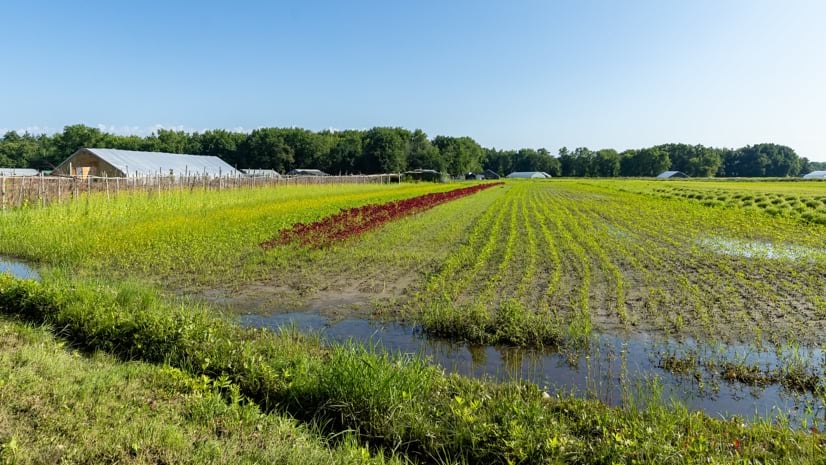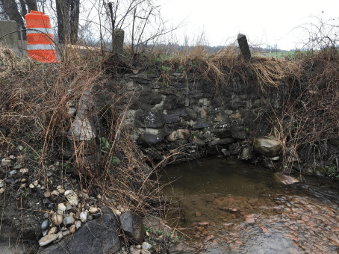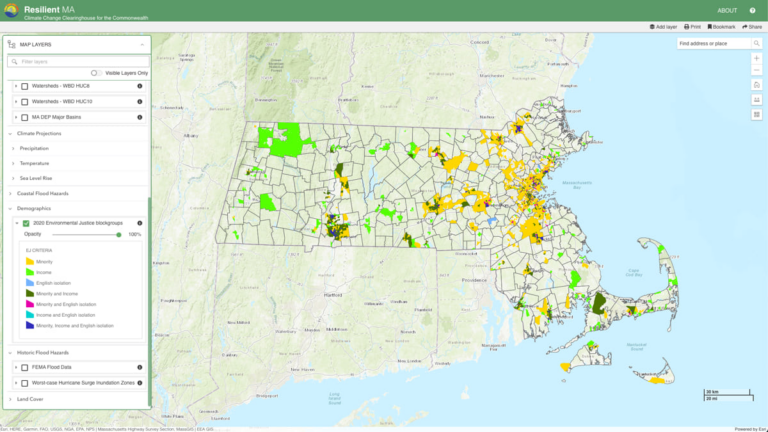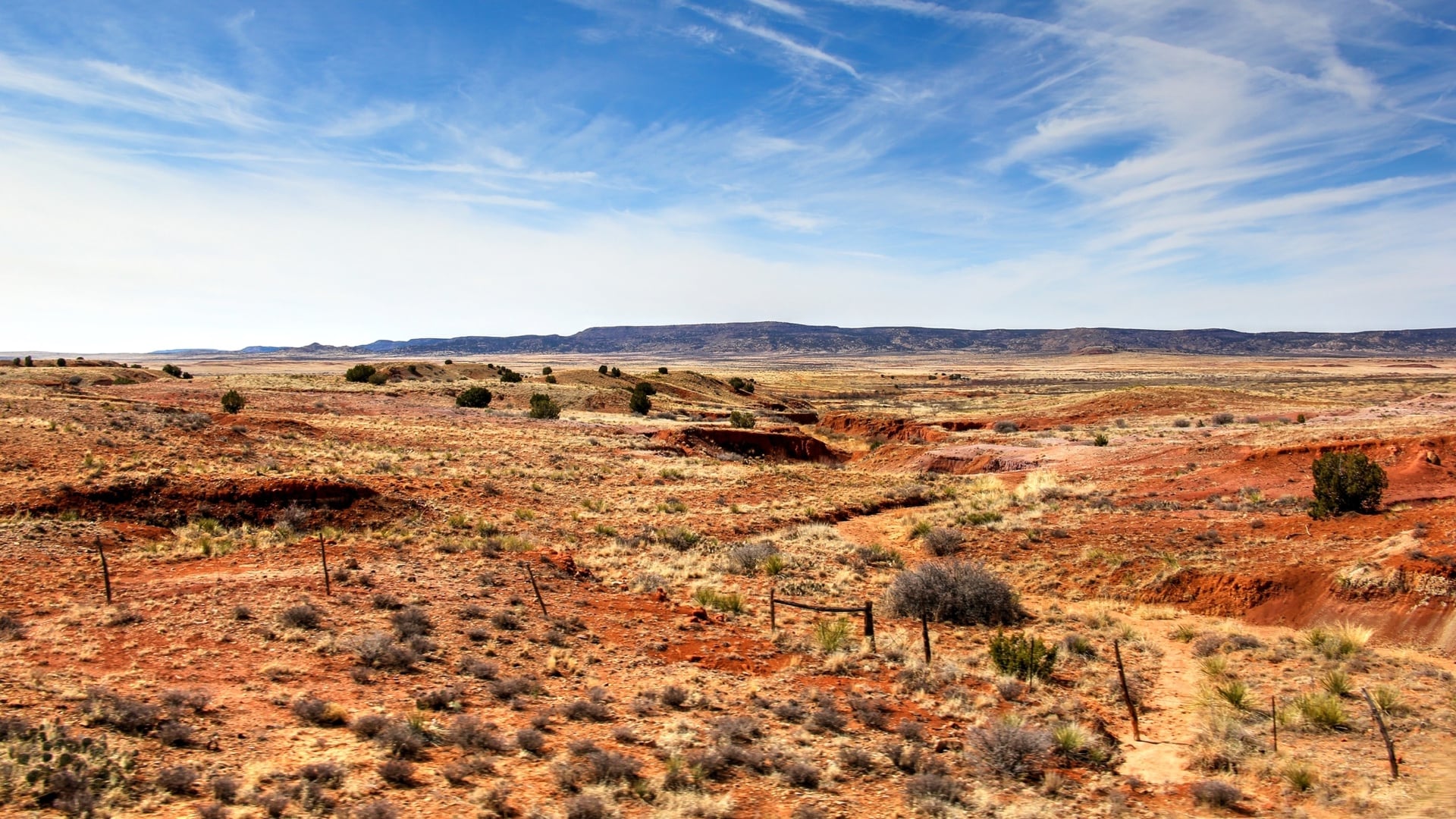

July 19, 2022 | Multiple Authors |
February 13, 2024

(Photo courtesy of Governor Healey’s office by Joshua Qualls, the Governor’s Photographer)
Farmers in mostly rural western Massachusetts know the cost of extreme weather. The past year has pitted them against a deep freeze in February, late frost in May, and torrential rainfall and flooding in July and again in September. Although climate change is a global threat, for these farmers, the effects hit hardest close to home.
Nearly 26,000 Massachusetts residents rely on agriculture for their livelihoods, and with 94 percent of the state’s farms being small or family-owned operations, the impact of these events has been environmentally, socially, and economically disruptive. For example, Natural Roots, a horse-powered vegetable farm in Conway, serves 500 farm-share customers who have been told not to expect winter shares due to flooded fields.
While larger coastal cities such as Boston have been proactive in their climate action, many Massachusetts farming communities like Conway often lack the staff or resources to keep pace. The Commonwealth of Massachusetts’s Executive Office of Energy and Environmental Affairs (EEA) works to bridge this gap. The EEA improves resiliency to climate impacts and helps communities adapt to climate change via accessible data, user-friendly analytical tools built with geographic information system (GIS) technology, and grants funding mitigation and adaptation measures. Building climate resilience means finding solutions to protect people and places, like rural farms and crop yields, from extreme weather events.
The EEA launched the ResilientMass Maps and Data Center to inform actions. Users can create and share maps showing climate change risks, forecasts, and adaptation strategies for their localities.
“The ResilientMass website is a one-stop-shop for climate resilience,” said Margot Mansfield, assistant climate scientist and coastal hazards specialist for the EEA. “We’ve been building tools and bringing in up-to-date data to help municipalities.”
As a national leader in the fight against climate change, Massachusetts continues to modernize its resilience efforts.
“The climate crisis is one of our greatest challenges, but there is enormous opportunity in our response,” said Governor Maura Healey, who signed an executive order creating the cabinet-level position of climate chief on her first day in office on January 5, 2023.
The governor also announced an expansion of the EEA’s Municipal Vulnerability Preparedness (MVP) grant program—MVP 2.0. EEA leadership has initially selected 29 towns and 1 tribe to participate in the fiscal year 2024-25 pilot round of the expanded MVP planning process.

The new pilot program addresses gaps in the first iteration of vulnerability preparedness. It allows communities to revisit and expand on previous resilience efforts, moving from planning to implementation. MVP 2.0 places a stronger emphasis on creating social resilience through an equitable and inclusive process. Municipalities, particularly rural or vulnerable populations, can use visualization tools and the latest data to guide decision-making with an equity lens.
Governor Healey and other state officials urge robust community engagement throughout the MVP 2.0 process. Grassroots organizers and city leadership will be involved at every step to ensure that local needs are being met.
“For MVP, the projects are often formulated by the town,” said Marissa Robertson, the deputy director of the MVP program. “Recent extreme weather events are bringing to light what should be a priority, like a dam that is at risk of collapsing from one major rain event.”
Earlier this year, the Healey-Driscoll administration announced the creation of a new role within the executive office of housing and economic development—director of rural affairs. This position will advocate for rural equity and agriculture and small business interests in western Massachusetts, complementing the EEA’s efforts to support underresourced areas.
Program managers and other experts within the EEA evaluate eligibility for MVP action grants based on factors such as location, climate vulnerability, and environmental justice populations (identified by demographic criteria). This lends greater weight to projects that would benefit underserved communities.
The Federal Emergency Management Agency (FEMA) has a new requirement to instill equity as a foundation for emergency management. Both state and local mitigation plans required by FEMA must include analysis of who will benefit. In fact, FEMA has made equity the first goal of its strategic plan, noting that underserved communities often suffer unjustly from disasters. As a result, disasters worsen inequities already present in society.
For towns lacking the expertise or resources to examine equity, MVP staff developed a web tool called Guides for Equitable and Actionable Response (GEAR).
“People can use GEAR to pick a community factor, such as housing or infrastructure, and visualize how it interacts with a climate hazard such as heat or flooding,” Robertson said. “We’re trying to make everyone as competitive as possible to get as much funding as possible to implement resilience projects.”

GEAR makes it easy for users to take advantage of advanced mapping tools without always needing to hire outside consultants. This ensures that projects stay rooted in local needs and inspire community engagement, Robertson added.
Promoting community awareness and engagement around climate risk has been a point of emphasis for the White House. The Climate Mapping for Resilience and Adaptation (CMRA) tool lets users explore real-time maps showing climate-related hazards, learn more about climate risks and adaptation, and find federal funding for resilience projects. GEAR takes this one step further, giving communities in Massachusetts an acute view of local climate priorities.
“There’s a heavy equity focus within the tool, which is something that a lot of towns and cities have struggled with,” Robertson said. If a user wanted to look at heat and health data, for example, GEAR provides guided explorations on how to use community maps and data layers to support equitable decision-making. “You might find out your town has three senior centers in a known hot spot. That’s a very vulnerable group living in an area of extreme heat. GEAR is designed to get you thinking about who’s vulnerable and what climate vulnerabilities they are exposed to.”
In addition to giving towns new tools, resources, and data to improve resilience, MVP 2.0 provides EEA staff with the chance to improve and expand their efforts.
“GEAR is a new tool, and we’re hoping that towns will provide a lot of feedback,” Robertson said. “We provided a how-to video, but we are considering offering trainings and one-on-one instruction for towns that need extra support.”
Flooding has exposed vulnerabilities, particularly in western Massachusetts. Farmers have suffered devastating losses. “That social impact ripples out very quickly because people are losing their jobs,” Robertson said. “They’re losing money based on one rain event. I think that’s really bringing the social resilience aspect to the forefront.”
Ultimately, the EEA wants what is best for the commonwealth—and the common good. Since there are no county governments, cities in Massachusetts have more decision-making power. There is a strong sense of unity between state agencies and local leadership. And when communities unite across regions, actionable responses to climate change grow stronger.
“Resiliency isn’t tied to one little neighborhood,” Robertson said. “You become more resilient if you’re able to do it as a region by adding capacity and leveraging shared resources.”
As Robertson and her team continue to support the towns involved in the MVP 2.0 pilot project, extreme events provide a nearly constant reminder of the impacts the team has already made.
“Towards the beginning of summer, we had some heavy rain and one of our towns, Deerfield, contacted us to say that its MVP culvert project held up great in the storm,” Robertson said. The town had been identified as an area vulnerable to flooding during the initial MVP planning process. Funding from MVP action grants in fiscal years 2021 and 2022 allowed the town to replace two priority culverts that helped avoid flooding.
“It’s been long enough since these projects have been implemented, we’re starting to get feedback,” Robertson said. “It’s validating to hear projects are working.”
Learn more about how GIS drives successful climate action and resilience.

July 19, 2022 | Multiple Authors |

May 17, 2022 |

February 7, 2023 |